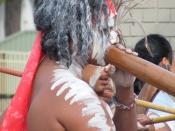In 1770 Captain Cooks encounter with the aboriginal people was marked with violence but the European colonization of the continent which followed 18 years later can only be described in terms of an invasion. This event was to bring devastating consequences for the aboriginal people who were occupying the country and living their lives in accordance with their own spiritual beliefs, laws, values and knowledge of the world. White European settlement brought with it the destruction of whole aboriginal communities and the decimation of the fabric to aboriginal society. The European views of the Australian continent, as "terra nullus" is significant as the whites did not recognize aboriginal communities as being civilized or as having and land rights.
The most terrible injustice of all was the almost total dispossession of Aborigines from their lands, carried out in the spirit of freeing the land from a pest. Under Whitlam certain land rights in the Northern Territory were granted.
In 1992 the High Court finally discovered the existence of native title in the common law. In one of the most important remarks of recent Australian history two of the High Court judges, Deane and Gaudron, called the dispossession of the Aborigines a matter, in Australia, of unutterable shame. In the following year, at Redfern, the Prime Minister, Paul Keating, spoke of the dispossession in identical vein.
After the dispossession, when frontier violence had more or less come to an end, the Aborigines were, in a startlingly radical fashion, stripped of their most fundamental legal and political rights. Charles Rowley once spoke of this as the pitiful transformation of the tribesman into the inmate. At one time or another, in one place or another, until the 1960s Aborigines were deprived of the franchise and basic property rights; prohibited from entry into certain designated...



Aboriginal injustices and a brief history recap
Bit brief and talks very general, not any real specific information.
0 out of 0 people found this comment useful.